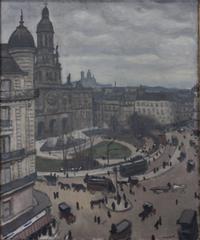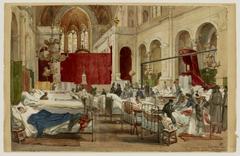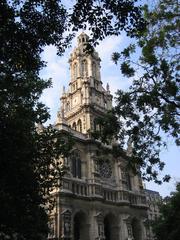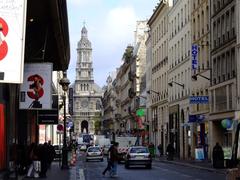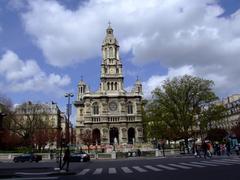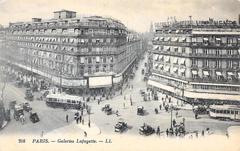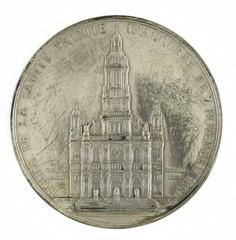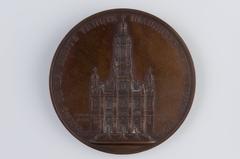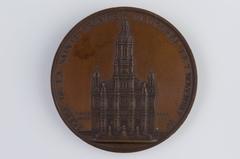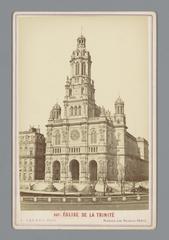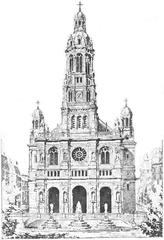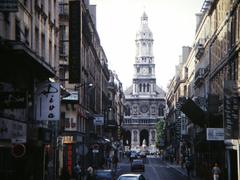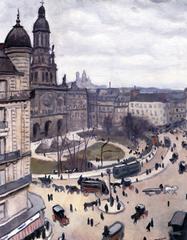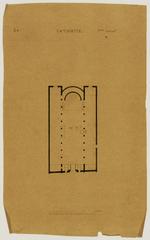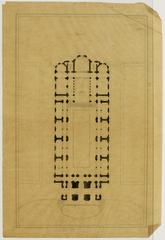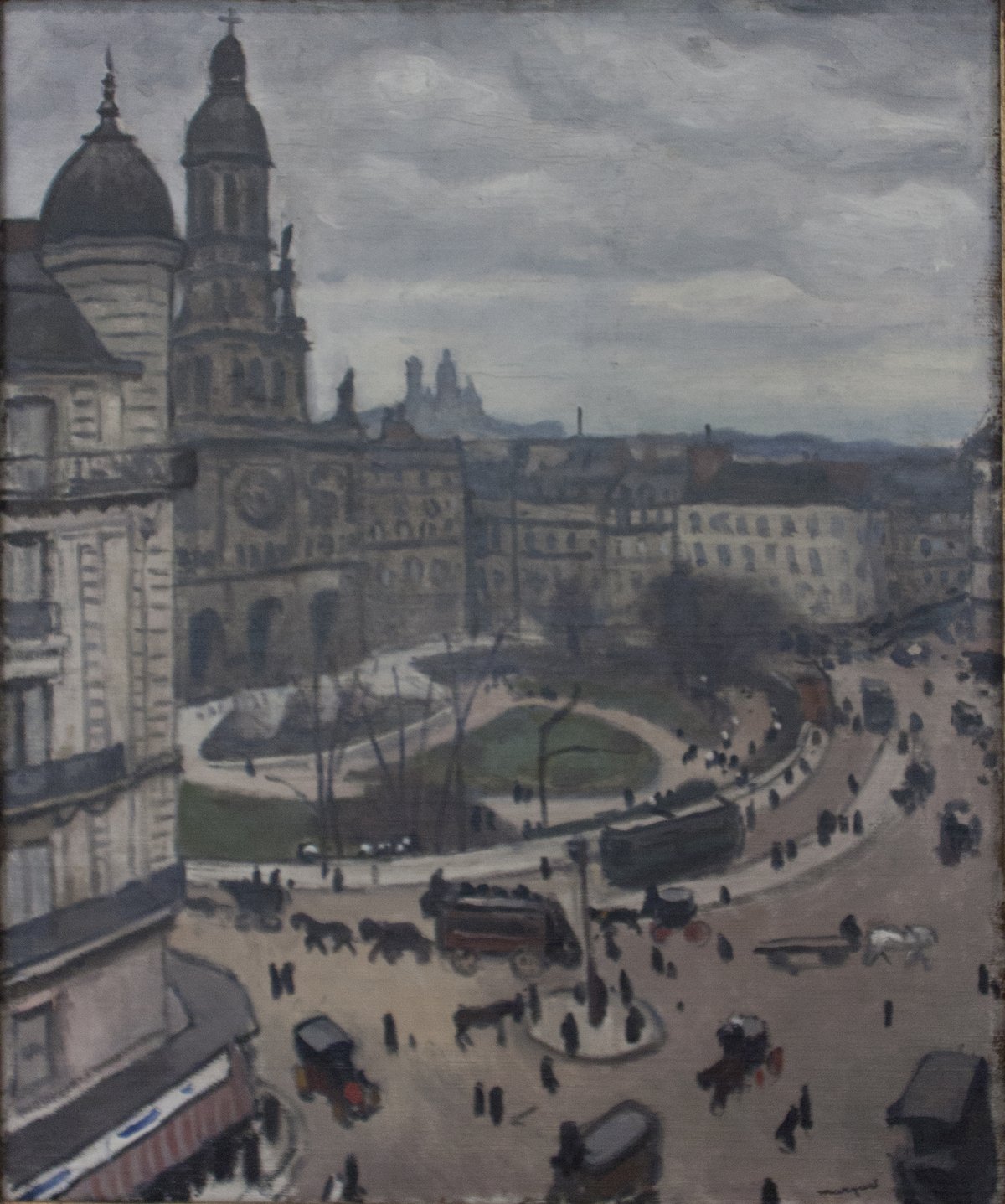
Église de la Sainte-Trinité: Complete Visitor Guide to Paris’s Historical Landmark
Date: 14/06/2025
Introduction
Église de la Sainte-Trinité, or La Trinité, is a remarkable neo-Renaissance church in Paris’s 9th arrondissement. Built between 1861 and 1867 during the Second Empire, it stands as a testament to the city’s ambitious urban transformation under Napoleon III and Baron Haussmann. Designed by Théodore Ballu, this church is not only an architectural marvel but also a site of historical, cultural, and musical importance. Today, La Trinité welcomes visitors as an active parish, concert venue, and historic treasure at the heart of Paris (artculturefoi.paris; zigzagonearth.com; latriniteparis.com; France Voyage).
Table of Contents
- Introduction
- Historical Background and Construction
- Architectural Highlights
- Notable Historical Events
- Musical Heritage
- Visitor Information
- Frequently Asked Questions (FAQ)
- Conclusion and Travel Tips
- References
Historical Background and Construction
La Trinité was conceived to serve the rapidly expanding neighborhoods of Paris during the Second Empire. Initially, a chapel on rue de Calais was inaugurated in 1850, succeeded by a wooden church in 1852. The need for a grander structure led to the commissioning of Théodore Ballu, who designed a monumental church as the centerpiece of a new urban square. Construction began in 1861 and concluded in 1867, with the church consecrated in 1913.
Situated at Place d’Estienne d’Orves, La Trinité was strategically integrated into Haussmann’s urban plan. The church became an architectural anchor, framed by radiating streets and surrounded by facades and gardens featuring fountains by engineer Jean-Charles Alphand (artculturefoi.paris; zigzagonearth.com).
Architectural Highlights
Exterior
La Trinité’s facade is a hallmark of Renaissance Revival architecture, characterized by a tripartite structure symbolizing the Holy Trinity. The 65-meter bell tower dominates the skyline, while the facade itself is adorned with sculptures representing Faith, Charity, and Hope, alongside enamelled lava panels by Paul Balze. Three monumental fountains and a symmetrical urban square reinforce the trinitarian motif (zigzagonearth.com).
The church’s metal framework, innovative for its time, allowed for vast open spaces and large windows, filling the interior with natural light. The exterior is further enriched by statues of saints and theologians, as well as richly decorated portals and pediments (Paris Promeneurs).
Interior
Inside, the church measures 90 meters in length and 34 meters in width, with a nave spanning 17 meters. The light-filled nave is flanked by side chapels adorned with 19th-century religious paintings and statuary. The apse features stained glass by Eugène Oudinot and Auguste Leloir, and the chancel arch boasts a monumental painting of the Trinity by Félix Barrias. The high altar, supported by green stucco columns, is a focal point, while the painted vaults and ornate décor provide an atmosphere of grandeur and serenity (patrimoine-histoire.fr).
Notable Historical Events
During the Franco-Prussian War (1870–71), La Trinité served as a field hospital. In the Paris Commune of 1871, it became a gathering place for revolutionaries, suffering damage before being reclaimed by government forces. The church also hosted the funeral of composer Hector Berlioz, underlining its cultural significance (France Voyage).
Musical Heritage
A defining feature of La Trinité is its grand organ, crafted by Aristide Cavaillé-Coll and inaugurated in 1869. This instrument, celebrated for its rich and innovative sound, attracted the renowned composer Olivier Messiaen, who was titular organist from 1931 to 1992. His legacy continues with regular organ recitals and concerts, making the church a center for sacred and contemporary music (latriniteparis.com).
Visitor Information
Visiting Hours & Admission
- Monday–Friday: 7:15 AM – 7:45 PM
- Saturday: 10:00 AM – 7:30 PM
- Sunday: 10:00 AM – 8:15 PM
Admission is free. Donations are welcome to support the church’s activities and upkeep.
Guided Tours & Events
Guided tours are occasionally offered—check with the parish or official website for schedules. The church also hosts regular concerts, especially organ recitals, and community events.
Accessibility
La Trinité is accessible to visitors with reduced mobility via ramps and wide aisles. For specific needs, contact the parish in advance (Cathedrale Sainte-Trinité).
Getting There
Located at 3 rue de la Trinité, Place d’Estienne d’Orves, the church is served by Metro Line 12 (Trinité–d’Estienne d’Orves station) and several bus lines. Major landmarks like Opéra Garnier and Gare Saint-Lazare are nearby (Wikipedia).
Nearby Attractions
- Opéra Garnier: Paris’s grand opera house, a short walk away.
- Montmartre: The historic artists’ quarter.
- Grands Magasins: Iconic department stores.
- Quartier de l’Europe: Noted for its artistic heritage.
Photography Tips
Photography is permitted, but visitors should remain discreet during services and avoid flash. The best light for photographs is in the morning, highlighting the facade and stained glass.
Frequently Asked Questions (FAQ)
Q: What are the opening hours of Église de la Sainte-Trinité?
A: Generally open daily—see section above for detailed hours. Check the official website for updates during holidays.
Q: Is there an entrance fee?
A: No, entry is free. Donations are appreciated.
Q: Are guided tours available?
A: Yes, but they are not daily. Consult the parish or official site for availability.
Q: Is the church accessible to visitors with disabilities?
A: Yes, with ramps and accessible entrances.
Q: Can I attend a concert or organ recital?
A: Yes, regular concerts are held—check event listings on the parish website.
Q: Is photography allowed?
A: Yes, but please be respectful during religious ceremonies.
Conclusion and Travel Tips
Église de la Sainte-Trinité is a vibrant monument where Parisian history, architecture, art, and music converge. Its unique blend of neo-Renaissance design, historical significance, and ongoing cultural programming make it a must-visit site for anyone in Paris. Plan your visit by checking hours and events in advance, attend a concert if possible, and explore nearby landmarks to enrich your experience.
For up-to-date information, event schedules, and guided tour availability, visit the official parish website and consider downloading the Audiala app for real-time updates and travel tips.
References
- artculturefoi.paris
- zigzagonearth.com
- latriniteparis.com
- France Voyage
- Ticketeaser
- Paris Promeneurs
- patrimoine-histoire.fr
- Wikipedia
- Cathedrale Sainte-Trinité
- Paris1972-Versailles2003
- Wanderlog
For enhanced engagement, include images of the facade, interior nave, stained glass, and the Cavaillé-Coll organ with descriptive alt text. Consider embedding a map and internal links to guides on other Parisian churches and landmarks.
